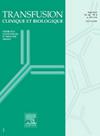Simple method to predict lymphocyte collection for chimeric antigen receptor T-cell engineering
IF 1.2
4区 医学
Q4 HEMATOLOGY
引用次数: 0
Abstract
Introduction
T lymphocyte collection is essential for CAR T-cell engineering in refractory hematologic malignancies but needs to be optimised. No guidelines have been established for predicting the amount of T lymphocytes to be collected. The quantity of lymphocytes and especially T cells collected depends on the pre-cytapheresis lymphocyte blood level (pcLBL) and the number of blood volumes (BVs) processed. Our aim was to define and standardise a simple method for predicting the number of T lymphocytes collected, taking into account the number of BVs processed and the pcLBL regardless of the procedures defined by different companies.
Methods
We used data from our large retrospective series, which included 407 collection sessions using the same cytapheresis method in 400 patients mainly being followed up for non-Hodgkin’s lymphoma (NHL) or multiple myeloma (MM). We initially analysed the performance of lymphocyte collections using collection efficiencies (CE1 and CE2), which are indices that determine the ability to collect as many cells as possible, and also assessed the percentage of neutrophils collected. Finally, we evaluated whether the number of T cells collected could be easily predicted by multiplying the pcLBL and number of BVs by an average factor.
Results
In our series, CE1 and CE2 for total lymphocytes and T cells were between 76 ± 15% and 69 ± 15%, thus confirming adequate cell collection. A low percentage of neutrophils was collected (9 ± 12%). Confirmation of adequate cell collection led us to consider the relationship between pcLBL and T-cell collection. We then demonstrated that the amount of T cells collected correlated with pcLBL, and could be predicted by multiplying pcLBL by 2.5 for each BV processed.
Conclusion
Easy prediction of T-cell collection is an important tool that can help apheresis and haematology teams monitor collection sessions, regardless of the companies involved and CAR T-cell technology.
嵌合抗原受体t细胞工程中淋巴细胞收集预测的简单方法。
T淋巴细胞收集是CAR - T细胞工程治疗难治性恶性血液病的必要条件,但需要优化。目前尚未建立预测T淋巴细胞收集量的指南。淋巴细胞特别是T细胞的数量取决于采前淋巴细胞血水平(pcLBL)和处理的血容量(BVs)的数量。我们的目的是定义和标准化一种预测收集的T淋巴细胞数量的简单方法,同时考虑到处理的bv和pcLBL的数量,而不管不同公司定义的程序。方法:我们使用的数据来自我们的大型回顾性系列,其中包括400名主要随访非霍奇金淋巴瘤(NHL)或多发性骨髓瘤(MM)患者的407次收集,使用相同的细胞穿刺方法。我们最初使用收集效率(CE1和CE2)分析了淋巴细胞收集的性能,这是确定收集尽可能多细胞的能力的指标,并评估了收集的中性粒细胞的百分比。最后,我们评估了收集到的T细胞数量是否可以通过将pcLBL和bv数量乘以一个平均因子来轻松预测。结果:在我们的系列中,淋巴细胞和T细胞的CE1和CE2在76 +/- 15%和69 +/- 15%之间,从而证实了足够的细胞收集。中性粒细胞收集率低(9 +/- 12%)。确认足够的细胞收集使我们考虑pcLBL和t细胞收集之间的关系。然后,我们证明了收集的T细胞数量与pcLBL相关,并且可以通过每处理一个BV乘以2.5的pcLBL来预测。结论:简单预测t细胞收集是一个重要的工具,可以帮助血液分离和血液学团队监测收集过程,无论涉及的公司和CAR - t细胞技术如何。
本文章由计算机程序翻译,如有差异,请以英文原文为准。
求助全文
约1分钟内获得全文
求助全文
来源期刊
CiteScore
2.50
自引率
11.80%
发文量
234
审稿时长
36 days
期刊介绍:
Transfusion Clinique et Biologique, the official journal of the French Society of Blood Transfusion (SFTS):
- an aid to training, at a European level
- the only French journal indexed in the hematology and immunology sections of Current Contents
Transfusion Clinique et Biologique spans fundamental research and everyday practice, with articles coming from both sides. Articles, reviews, case reports, letters to the editor and editorials are published in 4 editions a year, in French or in English, covering all scientific and medical aspects of transfusion: immunology, hematology, infectious diseases, genetics, molecular biology, etc. And finally, a convivial cross-disciplinary section on training and information offers practical updates.
Readership:
"Transfusers" are many and various: anesthetists, biologists, hematologists, and blood-bank, ICU and mobile emergency specialists...

 求助内容:
求助内容: 应助结果提醒方式:
应助结果提醒方式:


